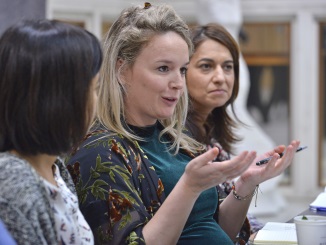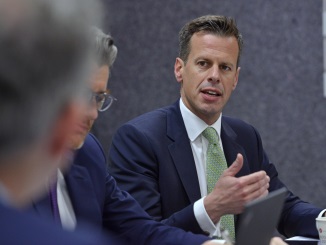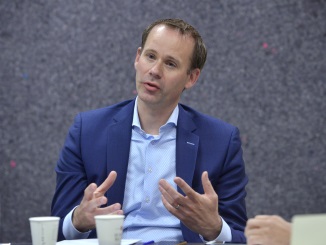
Overall ESG strategies are as important to investors as the specifics of green bonds, as they seek to avoid green-washing and encourage brown issuers to make the transition to sustainability.
This was a key takeaway from a Sustainabonds roundtable, hosted by ABN AMRO in Amsterdam on 17 May, where market participants spoke encouragingly of improvements in diversity and quality, and explained what they would like to see from EU initiatives.
Roundtable participants (left to right, above):
Bram Bos, lead portfolio manager, green bonds, NN Investment Partners
Sharon Visser, senior associate, funding and ESG relations, de Volksbank
Joop Hessels, head of green, social and sustainability bonds, ABN AMRO
Agnieszka Zdziennicka, head of treasury, PKO Bank Hipoteczny
Patrick Seifert, managing director, head of primary markets, LBBW
Francesca Suarez, green bonds specialist & ESG analyst, Mirova
Mehdi Abdi, senior fixed income portfolio manager, Actiam
Neil Day, managing editor, Sustainabonds & The Covered Bond Report
Bodo Winkler, head of funding and investor relations, Berlin Hyp
Sevinc Acar, investment director, fixed income, PGGM
A pdf of the roundtable can also be downloaded here.
Neil Day, Sustainabonds: Last year green bond market growth slowed quite a bit from its previous high levels. What is the picture this year? Has the market been developing at a satisfactory pace?
Joop Hessels, ABN AMRO: Absolutely. The pace has picked up quite significantly. Based on Climate Bonds Initiative (CBI) numbers, we are currently at $62bn*. If you compare Q1 2019 with last year, it was up over 40% — that’s very promising for the rest of the year, and there is a full pipeline.
The market is very busy. Yesterday we saw two corporate green bonds, which is very much welcomed by investors. Banks continue to be active — we have two parties here around the table who have announced their frameworks and we hope to see them soon. There are sovereigns on a regular basis and we are working with the Dutch state, which will next week open books for its first green bond, which will be EUR4bn-EUR6bn** — that will pick up the pace, too.
So there continues to be growth. And it’s not only from Europe, but globally. We see many different new countries and new types of issuers. We also see repeat issuers who appreciate and come back to the market. Currently 23% is from issuers new to the market, showing that the size of the repeat market. All in all, the market is picking up speed and that’s very promising.
Bram Bos, NNIP: Regarding last year’s numbers, some people have indeed said that it was a little disappointing. But it was perhaps worse than expected because of the market volatility — when you look at green bond issuance as a percentage of overall issuance, there was still a pick-up, so it should really be seen from that perspective.
I can only agree with what Joop was saying: this year there has been a very strong pick-up. And it’s important to emphasise that it’s not only the volumes that are positive, but the real benefit has been that we are also seeing many more different companies issuing green bonds. This year we’ve seen, for example, telecom companies for the first time, two have issued green bonds and another has published its green bond framework. We’ve seen a chemical company, LG Chem, issuing a green bond for the first time, and we saw Philips this week. So things are really developing in a very positive way.
This also reflects demand, because — as an asset manager, rather than an asset owner — we are also seeing a very strong pick-up in demand for green bonds to place in so many portfolios. So all in all a very positive development.
Patrick Seifert, LBBW: You could say that the corporate involvement has been the tougher part of the task. The market was initially largely driven by SSAs and to some extent govies, since they are perhaps the more obvious candidates. But once you see this moving to the real economy, to corporates, even to industries that you don’t necessarily expect to be particularly green, the concept is clearly broadening quite significantly.
We nevertheless also need the big names to be doing even more of green versus non-green to achieve the market volumes that everyone is ultimately looking for and that are being benchmarked to SDGs — which is perhaps the only reason why there is sometimes a bit of sense of frustration. Because there is this underlying feeling that we might not be reaching these goals. But that is not because the green bond market isn’t working; there are a lot of other factors involved, too.
Mehdi Abdi, Actiam: It’s not only in credit that we are seeing growth; what is really positive from my perspective is that we are seeing different sectors across fixed income. We are seeing many more green bonds in the SSA/covered bond space, with the Dutch State coming next week, for example, as Joop mentioned.
 Sevinc Acar, PGGM (pictured): It is also a positive development that green bonds are linking towards the Sustainable Development Goals (SDGs), because that also makes our life a little bit easier. In the past we only thought about risk/return, but nowadays we would like to see also the real world impact. The regulator would like to see that we take climate risk in general into consideration in our investment decisions. And if everybody works like this, then we can easily explain our performance or underperformance with respect to the impact in that way.
Sevinc Acar, PGGM (pictured): It is also a positive development that green bonds are linking towards the Sustainable Development Goals (SDGs), because that also makes our life a little bit easier. In the past we only thought about risk/return, but nowadays we would like to see also the real world impact. The regulator would like to see that we take climate risk in general into consideration in our investment decisions. And if everybody works like this, then we can easily explain our performance or underperformance with respect to the impact in that way.
Francesca Suarez, Mirova: We are also happy to see a bigger variety of issuers, particularly in the corporate sector, which is where there was something of a gap in our portfolio.
With regards to the SDGs, it’s something we are also seeing as a demand from the client side. They are always asking what the impacts on the SDGs are. It plays into the discussion of impact indicators, which we’ll maybe talk about later.
Day, Sustainabonds: Patrick mentioned factors holding up growth, but that it’s not necessarily the green bond market not working. There are various initiatives underway, such as the EU Sustainable Finance Action Plan, including the taxonomy and Green Bond Standard. Are they initiatives that will help the market grow? Or could they perhaps be too bureaucratic or burdensome?
Bodo Winkler, Berlin Hyp: It’s a little early to say, because we do not know exactly what the taxonomy will look like. We’ve seen the first draft and we should soon see a second — which will also be open for comment. The final results are expected in the fourth quarter of the year.
Due to our business, we had a very good look at the criteria for buildings, and there is a lot of room for improvement when the criteria are finalised. Just to give you some examples, requiring an improvement of 50% in energy efficiency if you finance renovations is quite a lot, and is not in line with what other initiatives demand — EeMAP, for instance, only asks for 30%. Then they somehow missed out the financing of existing energy efficient buildings. In contrast, they have a section on financing the construction of buildings, but this is not really appropriate for bonds: if you finance construction, you grant a development loan for two or three years, but what should you issue against this in the green bond market, a two or three year bond? In the current yield environment, who is going to buy that? So there are some elements that really need to be fixed.
On the other hand — not to come across as too negative — it’s very positive per se that the EU is dealing with the topic, that there is a first draft, and that this taxonomy will somehow serve the EU Green Bond Standard, too, because so far everything concerning standards is more about form than content.
So, to answer your question: if it is done properly, this could help the market a lot, because for corporates as well as banks it makes it easier to answer the questions: What is sustainable? What is not sustainable? What is green? And what is not? And to base their investment decisions on that. Of course, it also makes it easier for investors, because they are not confronted with the issuers’ own opinions of whether their business is green or not.
Acar, PGGM: We need to ensure the usability of the taxonomy. It should be like a catalogue, where you can look up which activities are green or not, and there should be little room for interpretation and subjectivity, to avoid greenwashing.
Hessels, ABN AMRO (pictured): The ultimate goal described in the action plan is that the EU wants to support the growth of the sustainable finance market — that’s an essential element that should hopefully be considered in all the outcomes.

I agree with Bodo that the first draft needs to have some calibration, especially for certain categories. Cicero, for example, said that a large part of the green bonds they have rated would be excluded under those criteria, and closing the market for several years while we can find new assets that fulfil them should not be the ultimate outcome.
On the other hand, the Green Bond Standard reflects a good number of suggestions or guidelines that will help the market. Many of those are already used by most issuers, so in that respect, it would support the market and could be helpful for the future.
One last point: if you read the Green Bond Standard, there is a lot of focus on trying to increase demand for green bonds, but — speaking to many existing and potential issuers — on the supply side it’s much more a question of their being able to gather the right assets. So increasing the underlying assets, increasing sustainable lending should be a priority, maybe by providing more benchmark information or stimulating new lending to projects. That would really help the market going forward. There is already huge demand — yesterday we did a transaction that was seven times oversubscribed and hence everybody got a meagre allocation. But either more funding is not required, or there are limited green assets available.
Seifert, LBBW: I would tend to agree. We talked earlier about corporates and the real economy moving closer into the focus of the green bond market, and ultimately it’s the end client that you need to have involved. The ideal situation would be for the end client to be coming to a bank saying, I want a green loan, rather than the bank having to convince the guy to take a green loan. Can the taxonomy help in that respect? Maybe yes, but Bodo basically answered the question: if it’s done well, it can help. In itself, I think it will not solve the problem. Each institution will still have to undergo that sometimes painful process of looking through all its activity and figuring out how that can be part of, first and foremost, a sustainable strategy and then a sustainable funding strategy, too. So from that point of view, as so often with regulation, it has to be good regulation to work and to help, otherwise it’s often painful.
Day, Sustainabonds: Did the EU initiatives play into the new issuers’ thinking or affect your work in any way, encouraging it, or making you wait until you knew what was coming?
Sharon Visser, de Volksbank: It wasn’t a case of thinking, oh, there is a Green Bond Standard coming so now we can set up a green bond framework — we have been working on it for three years. That is because we have ASN Bank as a brand and it is one of the most sustainable banks in the world, and we had to align the green bond framework with our sustainability strategy and our climate neutral balance sheet, so that was more the hiccup in the timeframe.
We looked at the EU initiatives but we didn’t take them into account, as such. In the main, we are compliant with what is expected from the standard and the taxonomy, so we won’t need to worry about that.
Winkler, Berlin Hyp: I agree with Joop, that the main point should be making more green lending possible and supporting this, and politics can do a lot towards this. Returning to the building sector, we are active in seven different countries in Europe and in each of these countries the energy performance certificates (EPCs) offer different information — you cannot compare them on a like for like basis. And in each country there is different regulation regarding storage of these EPCs and access to them — some are very advanced, others are not even good at collecting them. This is an area in which the EU and member states could do quite a lot to in having a common standard and making it mandatory for them to be stored at a central registry and made accessible. It would help a lot of businesses, including, of course, banks lending for the acquisition or refurbishment of buildings. That is just one example of where support could be applied, in addition to having a taxonomy and then a standard for green bonds.
 Agnieszka Zdziennicka, PKO Bank Hipoteczny (pictured): I can only add that I fully agree with what Bodo said. In Poland we faced the same issue while establishing our green covered bond framework: the problem was access to EPCs. If it were regulated at the EU level, that would definitely help a lot.
Agnieszka Zdziennicka, PKO Bank Hipoteczny (pictured): I can only add that I fully agree with what Bodo said. In Poland we faced the same issue while establishing our green covered bond framework: the problem was access to EPCs. If it were regulated at the EU level, that would definitely help a lot.
Hessels, ABN AMRO: In those countries where those databases have been made public — look at the UK or the Netherlands — issuers can map the public data with their own information, and then they are able to follow the CBI standards, for example, calculating the top 15% most energy efficient properties. If you don’t have access to publicly available information, it’s fairly difficult.
One other point is the focus in the Green Bond Standard not only on assets and investments, but also on expenditures. That’s a new category that we have seen in a number of transactions. It’s an interesting addition and could definitely help issuers, especially corporates, come to the green bond market, because they do not always have big capital expenditures, but do have a lot of turnover in certain certified products, or in other elements. But it’s a bit different than what we have seen so far, so it would be interesting to hear from the investor side how they look at this.
Suarez, Mirova: When it comes to expenditure, we do not yet have a firm position on this, because it also expands the number of things that can be financed through the green bonds. However, we would take it more on a case by case basis as it depends on what is actually being financed. If it’s something like maintenance or the improvement of a certain asset, then that would be very acceptable. However, if it’s the purchasing of sustainably certified products, we’re more stringent and would have to take a further look.
We acknowledge that it is easier for corporates that are capital intensive to issue green bonds over others that aren’t, so more thought would have to be put in for the latter when thinking of issuing a green bond. We also noticed that certain corporates are using the angle of a green bond to promote their sustainability strategy, which we believe is not necessarily the most effective way of showcasing their sustainability practices.
Bos, NNIP: We have taken a similar approach, looking on a case by case basis.
Take telecoms companies, for example: they use a lot of energy, but developing renewable energy is not their core business, so in that case including some form of PPAs (power purchase agreements) could be considered. It depends a little on the sector and the company’s activities.
The difficulty here is that if you issue a 30 year bond in relation to operating expenditure, what will your impact reporting include 20 years from now, because the initial spending will be gone?
But we are open to it because it probably makes it more possible for more issuers to come to the market.
Suarez, Mirova: I feel that a lot of issuers are just trying to understand, what is ESG? What are green bonds? I get a lot of questions about how we as an investor look at the ESG performance of an issuer and how that translates into investment. Some people think that if they want to showcase their ESG strategy, they need to issue a green, social and/or sustainability bond — they get the impression that’s the only way. But there are other ways of doing so — doing ESG-specific roadshows like in the equity space is an example.
Day, Sustainabonds: Following on from that, how do the investors take into account the overall ESG qualities of an issuer when looking at green bonds? And more broadly, what do you look for in green bonds?
Abdi, Actiam: At Actiam, we have always tried to be a responsible investor, but last year we began implementing ESG scoring across fixed income. We have an ESG team that analyses every issuer and, based on several criteria, assigns them an ESG score of between zero and 100. Green bonds always get a higher score — perhaps 75 or 85, and sometimes 100. In the past, we would do the credit analysis and look at the spread, and as a portfolio manager I would have to generate outperformance on this basis. But from last year onwards, we also have to outperform our benchmark in respect of the ESG score, so it’s in my interest to buy more green bonds with higher scores.
Furthermore, we exclude all issuers with scores lower than 20. Some companies really score very terribly in ESG in general and we don’t want to hold those names in our portfolio. So it’s not only the green bonds that are relevant, but also the issuer.
Day, Sustainabonds: Are there bonds that aren’t green bonds where the overall ESG score is higher than some green bonds?
Abdi, Actiam: Green bonds have in most cases a higher score than the non-green bonds of an individual issuer, but there are some issuers — such as KfW — which have a really high ESG score simply because they are really good from an ESG perspective, so their green bonds have the same ESG score as the issuer. Green bonds never have a lower ESG score than issuer score.
Seifert, LBBW: Can you give us a feeling of what scores lower than 20?
 Abdi, Actiam (pictured): There are some energy companies, for example. If those names come up with a green bond, we won’t buy them, because we don’t like the issuer in general. In our point of view, you should not focus only on green bonds, but what is your overall investment strategy and that’s more than just green bonds. Of course, green bonds help, but you should look at your whole portfolio, your total fixed income universe.
Abdi, Actiam (pictured): There are some energy companies, for example. If those names come up with a green bond, we won’t buy them, because we don’t like the issuer in general. In our point of view, you should not focus only on green bonds, but what is your overall investment strategy and that’s more than just green bonds. Of course, green bonds help, but you should look at your whole portfolio, your total fixed income universe.
Bos, NNIP: We have always taken a view that the greenness of a green bond is not only determined by the assets, but also what the broader strategy of the company is in terms of ESG — it’s just as important. Broadly speaking, that also has been the generally accepted way of looking at green bonds. When you look at the Green Bond Principles, they already say that there should be some kind of alignment of the assets with the broader environmental strategy of the company, or words to that effect, so it’s pretty common practice. We have very much the same approach.
Suarez, Mirova: Like Actiam, we have an ESG score, and we also have a green bond/sustainability bond score, and those two scores are actually separate. The ratings of the issuer and their sustainability bond are related but not necessarily the same. Usually, the rating of the sustainability bond is at least the same as that of the issuer, if not better.
We’re also to a certain extent open to issuers who are not so good from an ESG perspective issuing green bonds. There are certain companies in the green bond portfolio that wouldn’t be eligible for investments in our other portfolios because of their current sustainability performance. However, when you look at their green bond, you see the path they want to take, using the green bond as a way to transition into a greener business model and it translates into their sustainability strategy. Their annual reporting will, however, be very important to ensure that they do as promised.
Acar, PGGM: We would like to facilitate the greening of so-called traditionally brown companies as long as they have a credible business plan showing where they would like to go in order to reduce, for instance, their CO2 emissions and as long as they ring-fence the proceeds of their green projects. The idea behind green bonds is to make that energy transition happen, so as long as their assets are ringfenced, and they can make the transition, why not support that?
Day, Sustainabonds: And your broader approach to green bonds?
Acar, PGGM: Firstly, we are looking at whether the purpose of the bond is really green and whether the issuer has good credit fundamentals, and then we are also looking at the pricing, of course — you have to take this into consideration as a pension fund.
Bos, NNIP: What is really very important to us is engagement. We’ve seen that there is a very strong correlation between our being able to engage with companies and accepting their green bonds. If there’s no possibility of engaging, that is already for us a pretty strong signal that maybe there’s something wrong. So if we are not able to engage with companies, the risk of us labelling something as non-green is pretty high. Engagement is therefore very high on our priority list.
Suarez, Mirova: We’re the same and I believe most investors in the area are.
Day, Sustainabonds: Going back to the point about whether companies are really green: are there examples where you have been quite sceptical and avoided them?
Acar, PGGM: We bought an oil company bond several years ago, for example, but we re-labelled it as non-green, because we would like to be very transparent towards our stakeholders about what we buy. We liked the fundamentals and also the pricing, so we bought it on the secondary market as a non-green.
Hessels, ABN AMRO: That’s one of the key challenges the market currently faces. There are companies who want to adjust their business models and become more green, and we would like to have those parties in the green bond market, with investors willing to support that. But if you look at the taxonomy, it’s really fixed to certain asset categories, which could exclude some sectors. You need to have some flexibility and be able to look behind the specific assets, to the targets and ambitions of the issuer to be able to judge if it has the right credentials to issue a green bond, and a roadshow and engagement can be a part of this. This is a market that is still developing and the EU taxonomy should definitely have some flexibility to allow such companies to issue, because in the end that’s what we need, the not-so-green companies turning green, and green bonds are the perfect tool to finance that transition.
Seifert, LBBW (pictured): The strategy you have for making that transition is obviously something you want to make as clear as possible to investors.

There has been a limited supply of bonds and a big overhang of demand, so investors have been willing to look at new bonds with a view to buying them even if they are imperfect. It’s a market that’s developing, after all, and some issuers are transitioning faster than others — but selection criteria are becoming stricter, too.
In that respect, as an issuer you should probably be able to display some kind of ambition, by saying, at the moment I’m doing a quarter of my funding in green bonds, but going forward I want to do more. Or I want to be issuing senior only in green, for example. Or take it one step further: KfW has said, at some point in time we should become so green that we won’t need to specifically issue a green bond anymore. If you follow that logic, it’s impossible to separate the sustainability rating from the green bond. But because everyone is going through the transition at a different pace, there is not, let’s say, a clear standard, and you have to indeed take it case by case very often. And have issuers communicate with sustainable investors on what their green journey will look like.
Day, Sustainabonds: Looking at banks as issuers rather than corporates, who might be more single-sector, banks can have all sorts of exposures on their balance sheets and there have been some high profile protests against banks for their tar sands involvement, for example. Do you factor something like that into your analysis of banks’ green bonds? How strict or flexible are you? Is it complicated ESG scoring a bank?
Suarez, Mirova: Scoring a bank from an ESG perspective is indeed very complicated. For that reason, a lot of banks are not eligible for our investment universe.
When it comes to green bonds, it gets a bit difficult. We do ask what their exposure to stranded assets is, but — at least for now — it’s not a factor where we’d say because they have x amount it won’t be considered green. This is where the engagement part comes into it. Going beyond their green story, what is their strategy on the stranded assets? It’s really just part of that conversation and that’s why it’s very important that we get to speak to these banks about it.
Abdi, Actiam: Our ESG analysts look at banks’ exposures, and if the bank is really funding those companies we don’t like or those in sectors that are climate negative, that will lead to a really low ESG score, and then there will automatically be no investment in those banks from our side. So it does have an impact, what companies the banks are funding.
The next step is to engage with those banks and discuss this with them. What I like about our system is that we have had issuers curious about their score and asking why they are so low, when they thought they would have a higher score, so we tell them what they could change. One good example was when we gave an issuer some feedback about the transparency of their impact reporting and they actually implemented some changes, leading to a higher ESG score, and we increased our exposure to them. Working together in this way, issuers and investors can help green bonds grow further into a mature market.
Day, Sustainabonds: Perhaps we can now look more at issuers’ green bond strategies. Sharon, could you explain further how green bonds fit into your overall strategy, and why you are now going to be issuing green bonds?
Visser, de Volksbank (pictured): The sustainability strategy of course came first and afterwards we thought the green bond framework would fit perfectly into this. We want to be at the frontline of discussions around how to become more sustainable, and we like to create clarity around different “green definitions”, such as avoided, reduced and positive impact.

We are a monoline bank with only mortgages on our balance sheet. These mortgages have a negative impact on our climate neutral balance sheet, given the CO2 emissions of the underlying properties. Our focus is on reducing our negative impact and improving our positive impact, and on the asset side you do that by helping your clients improve their energy labels by looking into green mortgages and sustainable personal loans to finance this, and by training the mortgage advisors and making sustainability a standard topic during mortgage applications.
We are starting with A energy labels in our framework, but we would also like to incorporate new products in the future that finance energy efficiency improvements in properties. However, rather than looking at construction year or similar methodologies, we want to make sure that these are improvements we have financed ourselves and monitor these, so that we can measure our impact, the reduction in our negative impact, and steer clear of green-washing issues.
It is not a positive impact bond, as such, but you have to start somewhere and it contains less emissions and contributes towards our target of having a climate neutral balance sheet by 2030. When investors buy a normal bond, there are a certain amount of emissions per invested million, and when they invest in our green bond there will be fewer emissions per invested million. That is why we like to use the green bond framework as a communication tool as well, so we can create awareness and more clarity around the definitions used on positive, negative, reduced and avoided emissions in the different green bond frameworks.
Day, Sustainabonds: Have you faced challenges in sourcing the information you need to measure the impact?
Visser, de Volksbank: No, because we have already been carbon counting since 2015, so for us it should be very easy. But we of course want to move forward and be stricter on the real energy consumption, so we are working together with 11 other Dutch financial institutions — such as ABN — on PCAF (platform carbon accounting financials), which we initiated and chair as ASN Bank. We have agreed with some electricity grid managers to receive the actual consumption of houses, also through CBS (Statistics Netherlands) — I think the Netherlands is very innovative in this field. I would say EPC labels are a little bit old-fashioned. You have to start somewhere, and of course the Green Bond Principles refer to EPC labels, but in the future we would like to incorporate the real energy consumption as well in the green bond impact reports — you always have to strive for a new, stricter goal, of course.
Winkler, Berlin Hyp: But there are some weaknesses when it comes to the real consumption as you have to deal with occupancy rates and individual behaviour. Just because a house or commercial property consumes only a little energy, it does not tell you anything about how energy efficient the property is. This is why we focus on the energy demand rather than the consumption.
Visser, de Volksbank: Yes. If you take a G label property, which is the worst label in the Netherlands, and one person is living there, and then you have an A label with four or five persons there, the average energy consumption or gas consumption can be bigger than for the G label. But when you have the actual energy consumption you can better target your customers to help them improve their houses. But I agree — it’s a complex discussion.
Winkler, Berlin Hyp: I just want to argue against the notion that EPCs are old-fashioned. They are in the end quite a good measurement for making things comparable — but at the same time I totally agree with you about the benefits of looking at actual consumption, especially for private households.
Visser, de Volksbank: We only deal with private households, of course.
Winkler, Berlin Hyp: The commercial business is very different.
Seifert, LBBW: That is the situation you ultimately want to arrive at for your business: being able to tell your client you can help them improve and that you have a product to go with it, rather than making it a formality dependent upon them completing the right paperwork. This is something the ECBC is aiming to facilitate by inviting banks to learn from each other. Ultimately you can generate a benefit for the client, which then makes the whole thing way more useful going forward.
Day, Sustainabonds: Agnieszka, you discussed EPCs earlier on. Can you can tell us more about how the green bonds you are planning fit in with your overall strategy?
Zdziennicka, PKO Bank Hipoteczny: PKO Bank Hipoteczny is a part of PKO Bank Polski, which is the biggest banking group in Poland and the leader in terms of mortgage lending to individual clients. We are committed to the same CSR strategy as our mother company, and it is important for us to reflect and to react to the needs of society and the environment. We also provide support for our clients when they are taking personal and financial decisions, and that’s why ethical behaviour, trust and cooperation are very important for our group, being part of our business model.
We would also like to contribute to the development of the green bond market, because it’s an important tool for channelling investments towards making the climate and the environment better, not only for us but also for future generations.
PKO Bank Hipoteczny joined the pilot scheme of the Energy Efficient Mortgages Initiative in April. As the biggest mortgage bank in Poland, we would like to have the opportunity to be at the forefront of the standards that are being set within Europe and also how we can incorporate these into our Polish market, where the green concept is quite new, to be honest. We would like to first of all help our customers to lower the CO2 emissions, but also to improve and enhance their ability to service their loans — that’s very important for us.
To sum up, we believe that through this focus on energy efficiency, we as a bank, our clients, and our potential investors might directly contribute to Poland’s greenhouse carbon emission reduction targets — that’s our plan for the future.
Day, Sustainabonds: Bodo, in contrast to de Volksbank and PKO, you are a veteran of the green bond market. But you recently updated your framework — what was the thinking behind that?
Winkler, Berlin Hyp (pictured): Since we have had the framework in place, we have updated it every year so far. This is to keep it state of the art, reflecting how the green bond market has developed and improved. Every issuer needs to have a clear view on what they are doing, and what you thought was green business four years ago might not be green business anymore, and you have to react to that.

We had a major change in the framework last year when we found that our database is now at a very good level and we know exactly what data to collect so that we can look at the energy efficiency of buildings in a very precise way, measuring on the one hand the energy demand for electricity, and on the other hand for heating, and benchmarking those. Before that we also underwent a benchmarking exercise with external consultants to see: how good is our portfolio today? And what do we have to do to make sure it is still very good in 10 years? That led us to lower our thresholds, because what we found out was that while our previous approach was very good today, we would not have been able to maintain this high quality in the long run, so something needed to change.
And then of course one year after changing the framework and making it stricter, you have to reflect that in your impact reporting, too. That means looking more precisely not only at the assets, but also the baselines you employ, and measuring separately the carbon avoidance that is linked to heating energy and to electricity energy. That was a big task. What was exciting for us was that the information we have is now so good that we no longer have to work with very rough country-wide energy mixes, but can refer directly to the individual energy source of each and every building, and therefore use the exact data of the single energy provider in that region or for that specific property when it comes to district heating. It was really amazing to see how precise you can be today just because you have more data, and it was very good to ultimately publish that.
Abdi, Actiam: Impact reporting has been getting better by the day, but we are not there yet — there are still big differences between issuers. As a green bond investor, we want to be able to tell our clients what is the impact of their investment in green bonds, and we need to have the numbers to be able to do this.
I can compliment Bodo in this respect, since Berlin Hyp’s impact reporting is very good. They are transparent on their methodology and calculations, and it’s one of the examples we really like, so keep up the good work!
Day, Sustainabonds: Are the other investors getting what you want when it comes to impact reporting?
Acar, PGGM: It is improving all the time. Transparency is what we need, and also timeliness — we need the information so that we can report it in our annual report, too. And it should be accurate.
We have to cooperate with the whole investor community on this, and also with the issuers, because we need to speak the same language. What we measure should be equal with what, for instance, NN or Actiam report so that our clients can compare us against them, as they compared outperformance in the old times. In the new times we have to measure impact, too. And there should be a level playing field.
Abdi, Actiam: That is the whole problem within impact reporting: you have a lot of issuers with a lot of metrics, every issuer has their own impact report, and there is no harmonisation. I’m not saying that everything should be harmonised, but there should be more standards or something to make them more comparable — we can do the calculations ourselves, but that would make life much easier for investors.
Hessels, ABN AMRO: There are already some initiatives dealing with that.
Winkler, Berlin Hyp: Exactly. We are increasingly going in that direction. The first example was perhaps the MDBs’ (multilateral development banks’) harmonised framework, which was back in 2015. That was of course very much tailor-made for MDBs and their particular business. Another very good example is the Nordic public sector issuers with their position paper and their own principles. And then after this sub-group we have seen impact reporting being dealt with by the Green Bond Principles. Step by step they are touching one sector after another — just this year they have published recommendations for green buildings. If issuers were to adopt these recommendations, it would be to the great benefit of investors, of course, because it would improve comparability — but, to be honest, it would also benefit issuers, as they could also more easily compare themselves and have a clearer view on how good their business is from an environmental or sustainable perspective. For us, that is crucial. We offer a part of our return to borrowers who finance their green property with us — a 10bp discount — and ultimately our board is responsible for ensure that this money is being channelled towards those properties and those projects that deserve support.
Bos, NNIP: We really have already seen some good improvements over the last couple of years compared to where we were three years ago. Issuers are increasingly reporting on the same metrics, and that’s a good step forward. And it’s not only quantitative information, but more qualitative information, such as real project examples. Sometimes it’s simply impossible to report purely on quantitative metrics, so that combination is something we like, and we are seeing much more of it in impact reporting, which is very positive.
Another trend that we are also trying to push a little is reporting on a portfolio basis. In the past green bonds were reported on a line by line basis, but with the growth of the market that has become much more challenging for investors — three years ago we had a portfolio of maybe 20 or 30 green bonds; now it’s 130, so going through it on a bond by bond basis is almost a mission impossible. So what we are telling issuers is, please report on a portfolio level basis — it makes our life much easier, and it makes their life easier.
Suarez, Mirova (pictured): I agree. We never thought many issuers could do this on a bond by bond basis, so we created our database system to accept this information on a portfolio level — I have a separate Excel spreadsheet and do the work manually! Portfolio level reporting is sufficient for us, but I remember certain investors wanting it to be bond by bond.
 I completely agree with what has been said on impact reporting: comparability is key. And we have seen a lot of improvements in the past years.
I completely agree with what has been said on impact reporting: comparability is key. And we have seen a lot of improvements in the past years.
We ask for impact reporting because our investors ask for it, and one thing our investors still have a hard time comprehending — and I do, too, to an extent — is what exactly it means to have x number of tons of carbon emissions avoided. So we work with an external data provider to provide us with uniform carbon data and we calculate the extent to which all our portfolios — not just green bonds — are in line with the 2 degrees scenario. What we’re ideally looking to do is have something similar for the other impacts we see, whether that be water savings or biodiversity, for example. That is on our long term wishlist, but first things first.
Hessels, ABN AMRO: You see a lot of alignment now in what’s required and which elements are focused on. CO2 is something you commonly see. It’s also important that issuers use similar calculations. In the harmonised impact framework established by a group of development banks, for example, only the share of a project that is financed by the issuer is taken into account in their reporting — that sounds fairly simple, but not everyone in the market applies it the same way.
As the market grows, it will be all the more important for standard to be aligned. The Dutch banks have come up with this PCAF system, and that is for general bank reporting purposes, but it makes sense to align our green bond impact calculations with those standards, too, which is an interesting development.
Visser, de Volksbank: North American banks are also drafting a PCAF method now.
Hessels, ABN AMRO: And it’s really something that should be coming at an EU level. Bodo raised the issue of the availability of EPC data, and I can’t understand why something very simple like a conversion factor from energy to CO2 is not available at the European level. In the past the UK government provided it, but they stopped doing it — they are now focusing purely on the UK, maybe for obvious reasons. Providing EU-wide statistical data on an annual basis is something that could really support the market. Having one official EU source on the internet that provides annually updated numbers on emission factors, but also EPC data and market averages would be a great step towards standardisation.
Day, Sustainabonds: The question of pricing and whether green bonds command a “greenium” is a perennial one. Patrick, LBBW issued its third green bond this week, into a market that has weakened a little. What has your experience been, and what’s your view on how pricing on green bonds is developing?
Seifert, LBBW: I should firstly mention that ahead of the new issue we put in quite a lot of work as an issuer on updating our framework — in line with the thinking Bodo described. We finished that at the end of last week and then announced approached the market with our senior non-preferred green bond. As you said, the market was less stable than two weeks before, but you have to work with what you have.
The outcome of the deal itself was strong. We had some 150 investors, which at these fairly tight levels — mid-swaps plus 53bp for a EUR750m five year non-preferred senior — was quite good. For the record, we reported a greenium of 3bp-5bp versus fair value. We didn’t limit the size right away, which we could have done, and maybe that would have translated into even tighter pricing and, hence, larger greenium.
Some 35% of the deal was placed to, let’s say, really green investors, and what is clear to me is that green investors don’t live on a different planet. I believe Mehdi made a similar point earlier. If the market is difficult to read and investors don’t feel completely comfortable getting involved, it’s the same for everyone. On top of that, working out relative value is challenging, so trying to derive what the greenium might be becomes very difficult and somewhat theoretical when you are issuing in different parts of the cycle.
The way I see it, you are either green or you are not — it shouldn’t be dependent on whether or not you are getting a premium on an individual deal. If you believe in it — and LBBW surely does — then you may get rewarded on individual deals or the overall volume of your funding, and perhaps in the pricing of specific instruments relative to more conventional bond issuers. But it is becoming increasingly difficult to show a pricing benefit on each and every individual issue, because there is so much crossover between the two markets, green and non-green.
The strong demand undoubtedly helps, because I personally can’t recall when we’ve had 150 investors in a transaction like this for LBBW. And the feedback we have received from those green names on the updated framework and impact reporting, with around about a million tonnes of CO2 avoided on an annual basis, has also been fairly good,
And if conventional bond buyers like a green bond issuer and it is part of a trend they want to participate in, even though they are not green investors, no one will limit their participation. That’s another plus, even if you don’t read it in the statistics.
The discussion around a greenium reflects also frustration that the ECB is an ongoing presence in the market — they had been expected to withdraw at least gradually, and that could have led to more benefits from sustainable issuance, with the market expected to be less distorted. But then again, we have to deal with that. Nevertheless, in the long run, being engaged with a larger investor base can only help ensure access when market conditions are less favourable.
Bos, NN (pictured): The way we look at it is from a portfolio point of view. We have green bond portfolios that are 100% green bonds and it’s very important for investors to know how such a portfolio performs compared to a regular portfolio. And there is more and more evidence that, over the last couple of years, an isolated portfolio of green bonds does perform better than a regular portfolio — you see it, for example, in the Morningstar ratings: all the green bond funds are very highly rated at the moment. Of course, maybe it’s not a 100% fair comparison because the duration is a bit different or sectors are a bit different, but it is reality, and that is something that more and more investors are really appreciating.

And to be honest, many such investors won’t care about a couple of basis points more or less on a deal, given that they are probably performing one or two percent better in their portfolios, so they may be willing to give up a couple of basis points to help this market develop. On our side, we are also willing to pay a couple of basis points premium — it should not be more than that. From a portfolio point of view, green bonds look very attractive.
Acar, PGGM: I completely agree with Bram, but I would like to add that green bonds outperform in the secondary market because the investor base is also qualitatively much better than the regular investor base. SRI funds tend to be keen buy and hold investors.
Abdi, Actiam: Yes, green bonds are less volatile.
However, the market is growing and we see more and more green bonds, so we can be increasingly picky. Whereas in the past there was a green bond and everybody wanted it, there are now a lot to choose from so you don’t necessarily jump on them anymore. Of course, we always had to like a name before getting involved, but — even if there is a lot of demand from investors — we will be more picky going forward.
Hessels, ABN AMRO: That’s also supportive of the market. A lot of issuers put a lot of effort into making very strong frameworks, but if they see less strict transactions attracting similar attention, they might think that they can do likewise next time. So it would be good to support those clients who make the extra effort. You already see that in some cases, not only in pricing, but also in order books and diversification of investors. Yesterday’s transaction from Vesteda attracted not 80 accounts, but 150 accounts, and priced 5bp through the curve. That’s good for everybody.
Winkler, Berlin Hyp: I’ve never come across an issuer who entered the green bond market because they wanted to save funding costs from the get-go with their first green bond. So this whole debate has to me always seemed a little bit artificial. The price is where the market is on that particular day. You price your green bonds on your credit curve because you don’t have anything else and the price should reflect your credit quality, and this is no different with a green bond compared to a conventional bond in the end. If demand is bigger for that green bond in comparison to a potential conventional one, you might be able to tighten the spread a little bit more during bookbuilding than you would have been able to with the conventional bond. That’s it. As a matter of fact, there is an investor base that simply comes on top of your normal investor base, and so it is very likely that you are able to attract a bigger order book with a green bond.
Hessels, ABN AMRO: There are different considerations for less frequent issuers. We have conversations with potential clients who could issue a perfect green bond, but are still hesitant because there is hardly any pricing benefit. These are typically smaller corporate issuers who issue a bond once every couple of years but rely mostly on bank funding. For them to then make use of resources internally to step into the green bond market is much more challenging, especially if diversification is not a key issue and pricing is. And so while I absolutely agree on the benefits for frequent issuers — and of course we explain that to these potential issuers — but especially for infrequent issuers, sometimes they turn to alternatives, such as the green or sustainable loan market that is also developing and provides discounts on syndicated or bilateral loans.
Zdziennicka, PKO Bank Hipoteczny: As has been said by the investors and issuers, green bond issuance only makes sense when you are doing it as a part of an overarching sustainable strategy, not just as a gimmick to lower your funding costs.
We don’t have any experience of issuing in the green covered bond market yet*, but we are the regular issuer out of Poland as far as benchmark conventional covered bonds are concerned, and we are looking forward to engaging with investors on our future green bond issuance to build our green curve.

The roundtable was held in the Circl pavilion in Amsterdam, an initiative of ABN AMRO built entirely based on circular principles using recycled and re-usable materials.



